- Noxious Weeds in Quay County
PDF of Noxious Weeds in Quay County
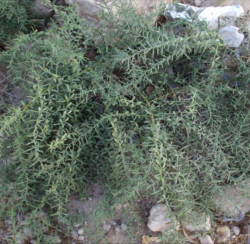
Description: (Class A) Noxious weed - Perennial - Unpalatable
-
Multiple green stems with fine branching, narrow to oblong leaves, Pea-like flowers that are pink, purple, or white
-
Extensive root system, can reproduce through roots or seeds (roots from up to 25 ft away) 1-4 ft height.
Habitat: Semi-arid areas, rivers, floodplains, disturbed areas, fields, ditches, and roads
Treatment: Healthy plant community, hand removal including most of root system, herbicides are effective, mechanical treatment can spread root fragments
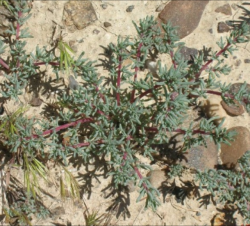
Description: (Class B) Noxious Weed - Annual forb
-
Stems are branched at the base, often purple or red, leaves are dull green to blue-green, look like fleshy cylinders
-
Flowers - dense bunches at leaf axil, no true petal, greenish-yellow to red in color, 2-18 in height
Habitat: Disturbed areas - fields, ditches, roads, pastures especially arid area with high alkaline or salt
Toxic: All parts of plant are toxic to livestock (oxalates) if ingested, especially sheep
Treatment: Healthy plant community, poor competitor mechanical removal effective for small infestations herbicides are effective, burning is NOT effective
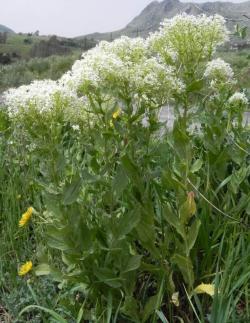
Description: (Class A) Noxious Weed - Perennial - 3 species in NM
-
Mostly single stems that are hairy with some branching near top
-
Leaves are alternate, gray-green, oblong to narrow, sometimes hairy and are round, oval or heart-shaped
-
Flower are numerous small, white, with 4 petals, Seed pods are round, oval or heart-shaped, 6-24 in height
Habitat: Irrigated pastures, rangeland, hay fields and disturbed areas
Treatment: Repeated cultivation 1-2 times per month for 2-4 yrs mechanical removal must remove root system, mowing in early flower growth stage may reduce seed production, herbicides are effective

Description: (Class B) Noxious Weed - Biennial
-
Very large pink to purple flowers
-
Leaves are dark green with a light green center and spiny margins 2-6 ft height
Habitat: Open areas, disturbed areas, ditches, roadsides, stream banks, Crowds out native vegetation
Treatment: Mechanical - cut roots below soil surface and remove stems before flowering, herbicides are effective, DO NOT - use fire or mow during / after flowering
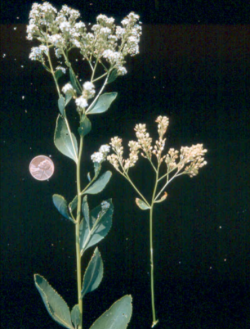
Description: (Class B) Noxious Weed - Creeping herbaceous perennial
-
Numerous semi-woody stems, waxy with some branching near top
-
Leaves are green to gray-green, oval to narrow, and do not clasp stem
-
Flowers are small, white with 4 petals to form a dense inflorescence that are rounded on top, 2-5 ft height
Habitat: Riparian areas, irrigation ditches, floodplains, and wetlands
Treatment: Healthy plant community, poor competitor, hand pulling all roots and seedlings, mowing is NOT effective control, herbicides are effective
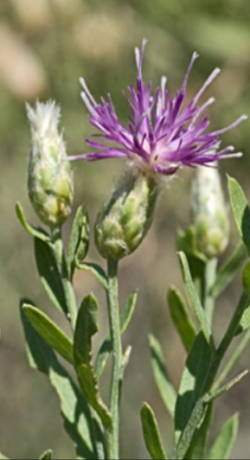
Description: (Class B) Noxious Weed - Herbaceous perennial
-
Numerous branching stems, lower leaves are alternate and lobed or wavy margins, upper leaves are linear or lanceolate, that are green to light green, leaves and stems covered with dense gray hairs
-
Flower heads are round with pink, purple, or white flowers. Below flowers are numerous green, papery bracts, 1-3 ft height
Habitat: Pastures, degraded croplands, alfalfa fields, rangelands, roadsides, riparian areas, irrigation ditches
Treatment: Prevention and early detection, large infestations are extremely hard to control, maintain a healthy plant community, herbicides are effective

Description: (Class A) Noxious Weed - Biennial to short lived perennial
-
Leaves often grayish hairs
-
Single flower head, usually pinkish-purple, sometimes white, below flowers are green bracts with dark brown to black comb-like tip, up to 4 ft height
Habitat: Disturbed areas - fields, ditches, roads, rangeland
Treatment: Mechanical must remove 3-4 in of root crown, introduced biological control agents, herbicides are effective, fire is NOT effective
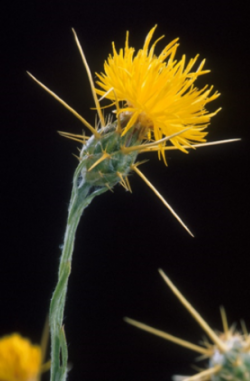
Description: (Class A) Noxious Weed - Annual
-
Stiff, wiry stems that are branched
-
Flower heads found at stem ends, with yellow flower and stiff, sharp, straw colored bracts (spines) below flower, 1-6 ft height
Habitat: Disturbed areas - fields, ditches, roads, pastures
Toxic: Toxic to horses if consumed
Treatment: Healthy plant community, frequent cultivation is effective, herbicides are effective, mow in late bud or early bloom to reduce seed production, burning is effective if done before seed production

Description: (Class C) Noxious Weed - Perennial tree or large shrub
-
Trunk is gray or brown, sometimes course or scaly
-
Leaves dull to gray-green with silvery underside
-
Extensive root systems with root crown and creeping perennial roots
-
Reproduces from seeds (small green "Olive looking") and creeping perennial roots, 16-40 ft height
Habitat: Grasslands, rangelands, woodlands, desert, and especially riparian areas, roadsides, ditches, open fields
Treatment: Herbicides are effective, mechanical is effective, prevention and early detection are the most effective

Description: (Class C) Noxious Weed - Small shrub or tree
-
Rough reddish-brown bark, numerous dense, thin stems
-
Small scale-like green / blue-green leaves
-
Flowers are long racemes with numerous small flowers that are white to pink / purple, 5-25 ft height
Habitat: Riparian area such as rivers, streams, lakes, irrigation ditches, roadsides and rangeland
Treatment: Mechanical is effective if the root crown is removed, herbicides are effective, burning is NOT effective
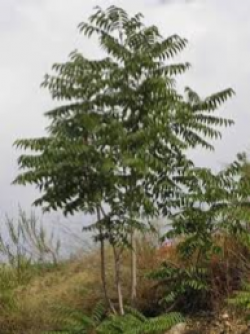
Description: (Class B) - Tree or Shrub
-
Deciduous tree that can tolerate shade and harsh soil conditions, erect with single trunk. Small trees have smooth, gray-brown bark, larger trees, rough bark
-
Leaves pinnate-divided and 10-22 pairs of opposite leaflets
-
Flowers in bunches, small, greenish-yellow to white, seed pods are flat, single seed, straw to reddish brown color, grow in bunches, pungent smell when broken, up to 65 ft in height
Habitat: Disturbed areas - fields, ditches, and roads as well as riparian areas and woodlands
Treatment: Healthy plant community, mechanical removal effective only if root crown and lateral roots are removed, herbicides are effective

